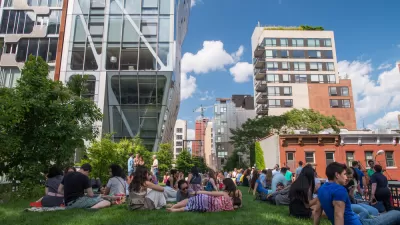'Culture Crash: The Killing of the Creative Class' by Scott Timberg argues that cities must defend and support local culture in the face of the homogenizing effects of the creative class.

Plenty of people have been accused of ruining cities in the 20th century. Henry Ford, Le Corbusier, Robert Moses, and Gerald Ford come to mind. Add to that list Roland Barthes.
 Barthes is not a planner, of course, nor is he American. He is a philosopher from Paris. His work has nonetheless devastated a certain class of people who live in cities. As Scott Timberg writes in Culture Crash: The Killing of the Creative Class, Barthes and other post-structuralist scholars set in motion a vicious cycle that devalued the creative arts and now threatens to undermine one of the most endearing approaches to 21st century urban development.
Barthes is not a planner, of course, nor is he American. He is a philosopher from Paris. His work has nonetheless devastated a certain class of people who live in cities. As Scott Timberg writes in Culture Crash: The Killing of the Creative Class, Barthes and other post-structuralist scholars set in motion a vicious cycle that devalued the creative arts and now threatens to undermine one of the most endearing approaches to 21st century urban development.
Richard Florida has built a hefty brand name with his "theory of the creative class," encouraging cities to attract young creative types, whom he defines broadly, as everyone from the bassist in your garage band to the person who comes up with names for pharmaceuticals. These "creative" enjoy lively downtowns (Brooklyn, San Francisco, Austin), dense development and attractive multi-unit housing, public transit and cycling, active public spaces, and bars, restaurants, and other amenities. Galleries, studios, and music venues are crucial too.
Florida argues that this approach makes cities not only fun but also wealthy, since creatives are if not the backbone then the face of the 21st century knowledge economy. Someone has to design all those webpages and film all of those YouTube videos. USC geographer Elizabeth Currid quantified the value of the creative industries to cities in The Warhol Economy, with impressive conclusions, particularly for New York.
Timberg tells a less buoyant story.
Even amid the era's profusion of media, writes Timberg, the very same artists, writers, musicians, and architects who used to make decent livings—even if they never became stars—now face grim prospects. Today's pop culture favors a winner-take all ethos (e.g., Taylor Swift, J.K. Rowling), leaving journeymen and -women with only scraps.
In many ways, he's telling stories that we already know. Symphonies are going silent. Newspapers are getting bought, digitized, and consolidated. Studios focus on dialog-free blockbusters to please foreign audiences. Novelists don't sell books anymore. Bands don't sell CD's anymore and barely make money on concerts. Architectural renderings get automated or outsourced. Writers endure daily existential crises and create content for free (look at Girls, or this review).
Timberg is not a scholar but an arts journalist. He conducted no studies to reach his conclusions, which amount to a clubby, insider-y lament. He bases much of his observations on anecdote and healthy doses of outrage, which is close at hand because Timberg clearly is clearly pals with a lot of people in the arts. It helps if you know your Camper van Beethoven, The Negro Project, and Patti Smith. As a polemic, though, it’s affecting, especially if you think art is a good thing in the first place. And you only have to walk down to where your local bookstore used to be to know that he’s at least half right.
Timberg views the consumption of culture as, ideally, a social, place-based practice. Bookstores, record stores, galleries, and even video stores thus played crucial roles in spreading the word about new talent. Those walls, record racks, and stages are the places that house art’s aura—making it a communal experience and not just a private delight. The creations may be intangible, but the institutions are brick-and-mortar. They are where art comes alive—not for the artist but for the viewer, listener, and reader.
The "middlemen"—one of several tainted words that Timberg would have us reconsider—who work at these stores are almost as important as the artists themselves. They provide the expertise and the spirit that gets consumers excited about culture. Timberg chides Florida for counting clerks among the mere "service class." Regardless, clerks and their stores are suffering in light of rising rents and what Timberg describes as a "faux-populist disregard for expertise."
Timberg does not focus directly on cities, but that's probably because he considers their role in the creative economy to be a given. Stores are just one aspect of that relationship, albeit an important one. "Strolling, in particular, is something these shops encourage, and, when they close, they often make a neighborhood less walkable," writes Timberg. Removing a beloved store from a city block can ruin the block’s appeal, "like knocking out Angelina Jolie's front tooth." The demise of the culture economy leads to "an abandonment of public spaces as well as the notion of a shared culture.”
As familiar as these outcomes are, Timberg explains why they are happening now. Technology, corporatism, consolidation, and functional illiteracy are a few of the obvious reasons. Others factors are more subtle.
Fed up with the simplistic binaries of the Cold War and the injustice of the western canon, critics in the 1960s and onward essentially decided that nothing meant anything anymore. It was Barthes who heralded the "death of the author," meaning that texts are floating signifiers with no connection to artistic intent. These critics insisted that prior notions of artistic greatness depended either on arbitrary aesthetic assumptions such that, as Timberg writes, "'good' is understood to be a suspect term based on the self-interested values of those in power."
By reducing creative works to political implications, post-structuralism strips them of their power to delight and to enlighten. Everything became analyzable—soup can, or the painting it inspired, became no more or less meaningful than Moby Dick or The Night Watch. "Fiercely anti-intellectual" film critic Pauline Kael is Timberg’s worst villain for celebrating lowbrow culture to the point of obliterating highbrow culture. Andy Warhol may have been an original, but Kael deserves blame for Jeff Koons.
The trouble is, when professors rail about bias and shifting signifiers in books and critics sensationalize works that are truly awful, the result is not that kids read books or watch movies more critically. It's that they resign themselves to blockbusters, and they don't read books at all.
From 1970 to 2003, the percentage of students majoring in humanities at American colleges fell from 30 percent to 16 percent. Today, it's hard to discuss the humanities without referring to "the crisis." Conventional wisdom holds that students shy away from humanities because they won’t get career training. Timberg turns this notion on its head. The humanities do not create producers. They createconsumers. "One of the things a humanities education has traditionally done," writes Timberg, "is excite young people about books and ideas, preparing them to become dedicated novel-readers, museum-goers, theater-frequenters, and so on."
And while the academy pursued ever more abstruse lines of criticism, arguing about how to unveil and reject expressions of power, the people with actual power—Walmart, Comcast, Verizon, and Fox, to name a few—have carried on.
"Members of the creative class created this mess themselves," concludes Timberg.
Cities can either accept that the creative class will not save them, or they can pursue policies to save it. Timberg obviously prefers the latter strategy. In fact, that even as the country becomes more homogenized, cities still have the chance to support diversity. As cities compete with each other in the crass marketplace of intra-national competition, so must they distinguish themselves. What better way than through locally sourced literature, architecture, art, and music? The media giants want the same artists to blast out of every station in the country, but that doesn't mean that cities can't put their own bands on stage in the town square or close down the streets for a locals-only music festival. What's good for Clear Channel is not good for cities.
Timberg defines his cultural ideal in urban terms. He writes, "Every decent-sized city would have an array of book and record stores and performance venues as well as a good newspaper that could afford arts coverage and assertive watchdog journalism." It’s arguable that these amenities should concern planners just as much as streets, sewers, and affordable housing do.
It’s not like cities don't already have enough to do and too little money with which to do it. But so long as some segments of America are turning away from urbanism and art alike, the creative class offers progressive cities yet another opportunity to distinguish themselves and, quite possibly, make themselves more prosperous in the process.
The life of the city, it turns out, may depend on the livelihood of the author.
Culture Crash: The Killing of the Creative Class
Scott Timberg
Jan 13, 2015
320 pages
$26.00

Trump Administration Could Effectively End Housing Voucher Program
Federal officials are eyeing major cuts to the Section 8 program that helps millions of low-income households pay rent.

Planetizen Federal Action Tracker
A weekly monitor of how Trump’s orders and actions are impacting planners and planning in America.

Canada vs. Kamala: Whose Liberal Housing Platform Comes Out on Top?
As Canada votes for a new Prime Minister, what can America learn from the leading liberal candidate of its neighbor to the north?

Washington State’s Parking Reform Law Could Unlock ‘Countless’ Acres for New Housing
A law that limits how much parking cities can require for residential amd commercial developments could lead to a construction boom.

Wildlife Rebounds After the Eaton Fire
Following the devastation of the Eaton Fire, the return of wildlife and the regrowth of native plants are offering powerful signs of resilience and renewal.

LA to Replace Inglewood Light Rail Project With Bus Shuttles
LA Metro says the change is in response to community engagement and that the new design will be ready before the 2028 Olympic Games.
Urban Design for Planners 1: Software Tools
This six-course series explores essential urban design concepts using open source software and equips planners with the tools they need to participate fully in the urban design process.
Planning for Universal Design
Learn the tools for implementing Universal Design in planning regulations.
Central Transportation Planning Staff/Boston Region MPO
Heyer Gruel & Associates PA
Institute for Housing and Urban Development Studies (IHS)
City of Grandview
Harvard GSD Executive Education
Regional Transportation Commission of Southern Nevada
Toledo-Lucas County Plan Commissions





























